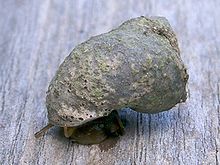| Littoraria irrorata | |
|---|---|

| |
| The shell of this Littoraria irrorata individual is covered in the lichen Pyrenocollema halodytes | |
| Scientific classification | |
| Domain: | Eukaryota |
| Kingdom: | Animalia |
| Phylum: | Mollusca |
| Class: | Gastropoda |
| Subclass: | Caenogastropoda |
| Order: | Littorinimorpha |
| Family: | Littorinidae |
| Genus: | Littoraria |
| Species: | L. irrorata
|
| Binomial name | |
| Littoraria irrorata | |
| Synonyms[3] | |
Littoraria irrorata, also known by the common name the marsh periwinkle, is a species of sea snail, a marine gastropod mollusk in the family Littorinidae.[3] The specific epithet irrorata means 'moistened' or 'dewy.'
This species occurs in salt marshes on the Atlantic coast and Gulf Coast of North America, from Massachusetts to Texas.
Some colonies of this species of snail are the only mollusks known to practice fungiculture.[4]
L. irrorata is an essential part of the salt marsh ecosystem. This is displayed in its strong relationship with Sporobolus alterniflorus, also known as Spartina alterniflora, a grass commonly found in abundance in salt marshes.[5]
- ^ "Littoraria irrorata". NCBI taxonomy. Bethesda, MD: National Center for Biotechnology Information. Retrieved 29 September 2017.
Lineage( full ) cellular organisms; Eukaryota; Opisthokonta; Metazoa; Eumetazoa; Bilateria; Protostomia; Lophotrochozoa; Mollusca; Gastropoda; Caenogastropoda; Hypsogastropoda; Littorinimorpha; Littorinoidea; Littorinidae; Littoraria
- ^ Say T (24 July 1821). "An Account of some of the Marine Shells of the United States" (pdf). Journal of the Academy of Natural Sciences of Philadelphia. II (2): 239–240. ISSN 0885-3479. LCCN 12030018. OCLC 1460713. Retrieved 18 January 2018.
- ^ a b Reid DG (2011). "Littoraria irrorata (Say, 1822)". World Register of Marine Species. Retrieved 16 May 2011.
- ^ Silliman BR, Newell SY (December 2003). "Fungal farming in a snail". Proceedings of the National Academy of Sciences of the United States of America. 100 (26): 15643–8. Bibcode:2003PNAS..10015643S. doi:10.1073/pnas.2535227100. PMC 307621. PMID 14657360.
- ^ Rietl AJ, Sorrentino MG, Roberts BJ (June 2018). "Spatial distribution and morphological responses to predation in the salt marsh periwinkle". Ecosphere. 9 (6): e02316. Bibcode:2018Ecosp...9E2316R. doi:10.1002/ecs2.2316.